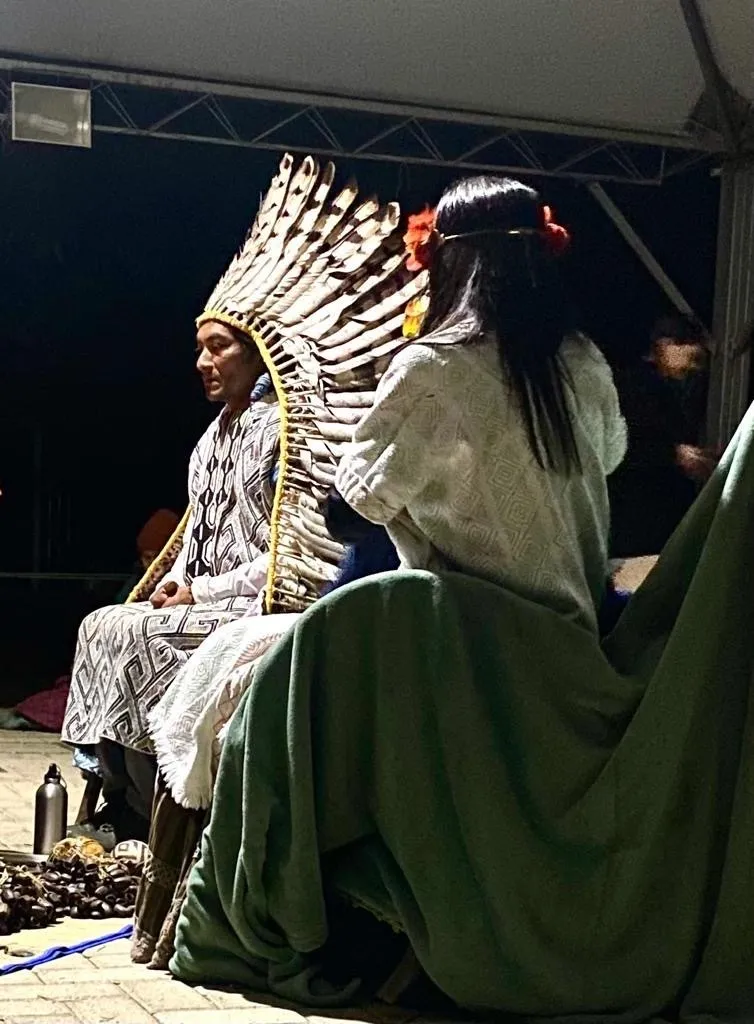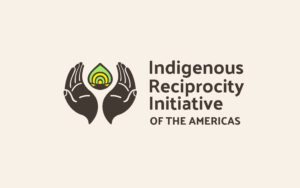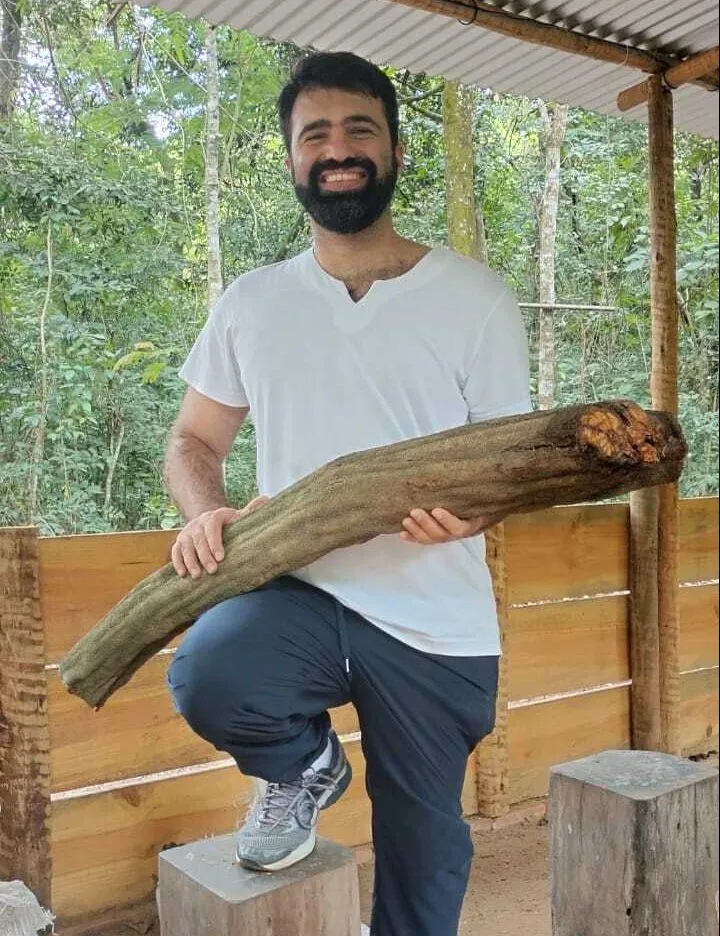- Eight Frequently Asked Questions About Ayahuasca Globalization - February 13, 2024
- Ten Tips for Standing in Solidarity with Indigenous People and Plant Medicines - January 18, 2024
- Genocide by Other Means: Indigenous Peoples and the War on Drugs in Latin America and the Caribbean - December 14, 2023
- Eight Frequently Asked Questions About Ayahuasca Globalization - February 13, 2024
- Liberté, Égalité et Fraternité? Santo Daime’s Fight for Religious Freedom in France - February 15, 2023
- A Call for Public Support Against the Current Demonization of Ayahuasca Practices in Spain - January 5, 2023
- Eight Frequently Asked Questions About Ayahuasca Globalization - February 13, 2024
- Ten Tips for Standing in Solidarity with Indigenous People and Plant Medicines - January 18, 2024
- Psychedelic Parenthood: A New Ancestral Way of Raising a Family - November 2, 2023
- Eight Frequently Asked Questions About Ayahuasca Globalization - February 13, 2024
- Ten Tips for Standing in Solidarity with Indigenous People and Plant Medicines - January 18, 2024
- Opening Remarks – Queering Psychedelics II - April 24, 2023

For our readers who might not be familiar with the culture of ayahuasca in Brazil, can you say a bit about its cultural and historical significance? How is ayahuasca regarded by Brazilians, and the Brazilian government?
The use of ayahuasca is central to a great number of Indigenous populations from the Amazon region. Since the 1930s, we have seen the emergence of religious movements that incorporated ayahuasca use and Christian elements, among other cultural and religious influences. It is a very particular phenomenon limited to Brazil. The Brazilian government has recognized the religious use of ayahuasca as part of the cultural traditions of Indigenous and African-Brazilian populations, since the 1980s. In 1985, ayahuasca was banned in Brazil for a short period of time,. However, due to a request from the UDV (União do Vegetal), the Federal Council of Narcotics (CONFEN) decided to reevaluate the matter, instituting a working group with CONFEN members and a number of scholars. After two years of research—in which the group visited ayahuasca churches in the Amazon and in the Southeast of Brazil, interviewed religious leaders, and did a thorough literature review—the working group decided to suspend the ban on ayahuasca permanently. In the 2000s, the National Council for Drug Policy (CONAD) instituted a multidisciplinary working group (MWG) to establish guidelines for the responsible use of ayahuasca. It was a trailblazing initiative, given that the working group included representatives of the main ayahuasca religions in Brazil. In 2006, the MWG published a report with a number of recommendations and guidelines for ayahuasca groups, such as the interdiction of trade and ayahuasca tourism, the prohibition of proselytizing and false advertisement, the need to keep a record of newcomers, and screening for potential cases in which the use is not recommended, such as in certain psychiatric disorders or in cases of people using certain medicines. In 2010, CONAD established a resolution reaffirming the legitimacy of the religious use of ayahuasca in Brazil, based on the Constitutional principles of religious freedom and the safeguarding of Indigenous and African-Brazilian cultural traditions. Also, in the 2000s, the Institute of National Historical and Artistic Heritage (IPHAN), at the request of ayahuasca religions in Acre, started a recognition process of the religious use of ayahuasca as an intangible cultural heritage in Brazil. This ongoing process has been permeated with tensions on what groups and practices will be covered by the request, with the growing voice of Indigenous peoples. However, the shift from drug policies to cultural heritage policies attests to a new moment for the use of ayahuasca in Brazil, reaffirming the Brazilian government’s recognition of ayahuasca as a legitimate religious and cultural practice. Despite the government’s stance, the use of ayahuasca is relatively unknown in certain parts of Brazil, and it is common to find newspaper articles that exoticize ayahuasca and associate it with drug abuse. Nevertheless, with the recognition from the Brazilian government, along with the contributions of anthropological and biomedical research, public opinion shifted and we started to see articles that recognized the religious and cultural value of ayahuasca. We must stress, however, that ayahuasca culture suffered a significant backlash during Bolsonaro’s government, especially due to the dismantling of important government branches and policies along with the prejudice from evangelical churches that consider ayahuasca as something evil. We will see what the future holds for the ayahuasca community with the new term of President Lula.

More people have become interested in psychedelics in general, and some have sought ayahuasca experiences as a form of psychedelic tourism. What effect has that had?
It is undeniable that we are witnessing a psychedelic renaissance propelled, among other factors, by the world ayahuasca diaspora. Since the 1990s, we have seen a significant increase of people from the Global North go on tours to the Peruvian, Ecuadorian, Colombian, and Brazilian Amazon to participate in ayahuasca ceremonies. The legal prohibition of ayahuasca in certain countries is one of the reasons people choose to travel to the Amazon, engaging in a form of medical or spiritual tourism. This practice has increased over the years as the result of the increase in information available on the internet. While a good number of people have meaningful and positive experiences, the increase in ayahuasca tourism can also be understood as a new form of colonial practice, since a lot of drinkers are following their self-interest for healing and personal growth, without considering the impact of this new form of tourism on local communities, not only their culture or people, but also the environment. Thus, the global ayahuasca diaspora has been accompanied by the commodification of ayahuasca, as ayahuasca has become part of a global supply chain that involves monetary exchange. We cannot talk about transnational cultural flows and ignore the modern transnational economic sphere. Besides sensitive issues that revolve around the commodification of ayahuasca, such as intellectual property, biopiracy, cultural appropriation, and monetization, there is also an environmental impact that is a byproduct of this recent trend. As the demand for ayahuasca grows by the day, this commodification has not only environmental impacts but also social and economic impacts on the populations of South American countries, raising broader issues. In addition, there is a risk of unscrupulous practitioners exploiting tourists in search of a spiritual experience. That said, we must recognize that the flows of people from the Amazon to Europe, North America and elsewhere, and the journey of people from all over the world to the Amazon looking for an “authentic” ayahuasca experience, seems like a trend that is here to stay. The question is: How can we ensure that the local communities are being respected and are also getting something positive in return, not only financially but in terms of opportunities to expand their networks and raise awareness about their needs and aims? In other words, how can these transnational cultural flows lead to meaningful exchanges, instead of promoting new forms of colonialism? In addition, it is important to assess and address the impacts of these cultural exchanges and the changes they promote, such as the creation of new rituals and traditions with the incorporation of new musical instruments and musical styles. But there are also deeper changes, such as the intensification of social inequalities.

Shop our Collection of Psychedelic T-Shirts.
Brazilian researchers are studying the effects of ayahuasca, often working with churches. In the U.S., some researchers are trying to do the same; is there an ethical way to do this, while ensuring Indigenous peoples and traditions are respected?
The various forms of preparation and use of ayahuasca by Indigenous peoples and traditional communities can be framed as “traditional knowledge associated with genetic heritage.” According to Brazilian law, any new research or technological development involving the composition, preparation processes, and use of ayahuasca by different Indigenous peoples is considered “access to associated traditional knowledge of identifiable origin” and, therefore, it requires prior, free, and informed consent of at least one collective representative of the holders of that knowledge. Traceability is an important feature of the legislation, since it ensures compliance with the rights of holders of associated traditional knowledge, especially in guaranteeing that an adequate procedure is carried out to obtain consent, respecting the social organization of each people or community, and ensuring benefit sharing in the case of commercial exploitation of products resulting from the research or technological development carried out in the previous stage. Although the US is not a signatory of the Nagoya Protocol, it can be seen as an important initiative in this direction. Related to this discussion is the concept of “epistemic injustice” that has started to be discussed in the realm of biomedical ayahuasca studies recently.
Find more information on the upcoming Psychedelic Culture Conference.
What are your concerns about the growing popularity of ayahuasca in the US? And what might be the benefits of the growing popularity?
According to a report made by ICEERS, the US is the country with the most people drinking ayahuasca in the world. The growing popularity of ayahuasca in that country can contribute to the awareness of the cultural and historical value of Indigenous traditions and religious groups that use it. It can also contribute to the debate on the use of psychedelics and therapy. This is an extremely important issue, since ayahuasca groups are frequently victims of social stigmas. They not only face cultural prejudice but are also being targeted as potentially dangerous criminal organizations. This seems to be the trend currently dominating Europe, where the criminalization of ayahuasca and the number of arrests is reaching an alarming rate. The fact that there are two established ayahuasca churches in the US, the UDV and Santo Daime, sets an important example for other countries. It is not a secret that the US has sought a leading role in the War on Drugs. If a country like the US, which has invested a lot of time and money in prohibitionist policies, can find room to accommodate the religious rights of ayahuasca groups, then it’s clear that there are ways for governments to establish compromises and respect the rights of religious groups and traditional populations. Nevertheless, the growing popularity of ayahuasca can also give rise to sensationalist headlines, misleading information, and to unsafe practices. It can also intensify the commodification of ayahuasca, as it can be seen as just another psychedelic substance in the growing US market and there is a risk of reinforcing the colonialist practices attached to it. However, we must stress that there is no evidence to this date of a potential illegal market of ayahuasca and its use is limited to a restricted number of groups in the United States.

As more groups and churches begin to form around the plant medicine, what do you and Chacruna help provide?
One of Chacruna’s goals is to bridge the gap between the traditions of plant medicines and the emergent field of psychedelic science, between “traditional ceremonial use” and clinical and therapeutic settings, and between academia and the general public. Chacruna’s main role is to educate the public and promote awareness of the cultural and historical legitimacy of these substances so they will cease being stigmatized and outlawed. We developed the Council for the Protection of Sacred Plants and the Ayahuasca Community Committee. The goal of the Council for the Protection of Sacred Plants is to advocate for the legality of sacred plant medicines among Indigenous Peoples and non-Indigenous psychedelic churches. The Council promotes legal harm reduction practices to protect ayahuasca drinkers and provide education about the conservation of plant species, intellectual and environmental legislation. We have published a resource on best practices, teaching communities to learn about the Religious Freedom Restoration Act (RFRA), and encouraging them to self-organize and self-regulate. We have also mapped legal issues and the main public controversies around ayahuasca on a global level; provided information about law enforcement patterns; monitored the legal developments involving ayahuasca churches’ religious exemptions cases (such as Soul Quest’s, NAAVC, and others); provided spiritual, emotional, and legal support and resources for folks facing legal encounters with law enforcement; acted as expert witnesses in cases of prosecution; supported the Church of the Eagle and the Condor federal case and FOIA requests to the DEA and Customs and Border Protection and an Amicus Brief in support of a church’s religious rights under RFRA. We also published, in collaboration with renowned scholars, a critique of a biased DEA report on ayahuasca. The Ayahuasca Community Committee in turn has developed materials such as “Ayahuasca Community Guide for the Awareness of Sexual Abuse,” “The Legal Resources Companion to the Guidelines for the Awareness of Sexual Abuse,” “Community Outreach,” “Sexual Abuse Survey,” and “The Commodification of Ayahuasca,” among other initiatives.

Is it important that people recognize and keep to the culture and tradition of an ayahuasca ceremony that came from South America, and why or why not?
It is crucial that the traditions of Indigenous peoples and ayahuasca religions are recognized for their historical, social, cultural, and environmental value. In a context where the Amazon Forest has become the center of global attention regarding climate change, the recognition and promotion of the practices of traditional populations are part of Amazonian history. There is no conservation possible for the forest if the traditional populations are not protected as well. In other words, the well-being of the traditional populations is essential for the preservation of the Amazon biome. This has become a political issue and a crucial theme in the contemporary agenda of Indigenous peoples that drink ayahuasca. This environmental agenda intersects with issues from the ayahuasca landscape, such as heritage policies, cultural appropriation, commodification, biopiracy, and others. Therefore, safeguarding traditional culture and protecting the environment cannot be thought of as something separate. This is also true for ayahuasca religions, which have been promoting environmental projects for decades. There can only be real inclusion and diversity if the historical and cultural value of the Global South, with its cosmologies and ethos, are recognized and respected.

Discover the Indigenous Reciprocity Initiative of the Americas
How do you feel about people of a different race and culture using and promoting this psychedelic? Is it cultural appropriation?
We have witnessed a boom related to the world ayahuasca diaspora that has led to reinventions and controversies. Once a practice leaves its geographical setting and is inserted in different social, cultural, political, and economic contexts, changes are inevitable. In fact, the emergence of Brazilian ayahuasca religions is intrinsically attached to the cultural exchanges between Indigenous peoples and rubber tappers from the Amazon, which led to a new form of ayahuasca use that incorporated elements of Indigenous traditions and other features from folk Catholicism, African-Brazilian religions, Kardecist spiritism, and European esoterism. This is not a new thing. However, the current landscape is quite different, and ayahuasca is part of a global trend that goes far beyond the geographical and cultural limits of the Amazon. The use of ayahuasca has gone through some significant reinventions since it was inserted in the urban centers of South America and beyond. Ayahuasca has been used in meditation sessions, in the treatment of drug addiction, in psychotherapy sessions, and for artistic inspiration. There are also new developments that emerged through the connections between ayahuasca religions and Afro-Brazilian religions and neo-shamanism and other therapeutic and spiritual urban trends. These practices have altered the urban scene of the use of ayahuasca, leading to the creation of neo urban-esoteric and therapeutic networks. Frequently, these contemporary groups have some type of relationship to traditional ayahuasca religions or to Indigenous peoples, forming an intersection between urban networks and the traditional Amazonian uses of ayahuasca. Considering the unseen pluralization and expansion of the use of ayahuasca, it is not up to us, as anthropologists and researchers, to define what practices are part or not of legitimate traditions, and who is or is not a bearer of certain traditions. That said, it is important to stress the risks of biopiracy and to highlight the need for access and benefit-sharing legislation, and other policies that focus on the rights of Indigenous and traditional populations. Indigenous peoples have been part of the new urban ayahuasca scene and have also been protagonists on the political agenda of ayahuasca in South America. These groups are claiming their role as bearers of ayahuasca tradition, developing forms of self-regulation and demanding that local and national governments develop an agenda for the Indigenous use of ayahuasca. In that sense, their increasing presence in South America’s major cities is not only legitimate but is part of their rights as Indigenous peoples. Once the Indigenous use of ayahuasca spread to different settings, these groups have faced multiple challenges, especially legal ones, forcing them to adapt to the legal frame and the guidelines on the religious use of ayahuasca. In sum, this is very complex issue since the traditions of ayahuasca use can only prosper and survive in the contemporary landscape if they reinvent themselves and adapt.

There are now many shamans traveling north and leading ceremonies in countries like the US. Is this widely accepted? What can we do about the global expansion of ayahuasca?
Unlike some Brazilian ayahuasca religions, such as a branch of Santo Daime and the União do Vegetal, that have won the legal right to use ayahuasca in a religious context, there is no regulation for the Indigenous use of ayahuasca in the US. This has created legal problems for Indigenous populations as they begin to insert themselves more and more in the world ayahuasca diaspora. Without question, the Indigenous peoples are the originators of ayahuasca, and they are the bearers of a rich historical and cultural tradition. It is crucial to open up a dialogue to search for the best way to accommodate these traditions into the contemporary transnational cultural flows. Let’s remember that the scientific name of the ayahuasca vine, Banisteriopsis caapi, was appropriated by botanist Richard Spruce from the culture of the Tukano people of the upper Rio Negro, who have known ayahuasca as caapi/kahpi since time immemorial. How are we accommodating the Indigenous translational expansion of ayahuasca and giving back to these populations? One of our biggest concerns is that these groups are respected and that they can find their own path for the use of ayahuasca in the urban centers of South America and beyond, without having to conform to regulations that were established focused solely on the religious use of ayahuasca. Also, it is crucial to talk about reciprocity. Chacruna has developed the Indigenous Reciprocity Initiative of the Americas (IRI), a program consisting of a network of different Indigenous groups in partner organizations engaged in various projects involving food and water security, agroforestry and environmental health, fighting for land rights, and building economic and educational support. The projects developed by IRI are designed and implemented by Indigenous communities to meet their own needs and priorities, rather than something imposed from the outside. We invite everyone to learn and support.
Note: This article was originally published in MAPS Bulletin: Volume XXXIII Number 3 • 2023.
Art by Mariom Luna.
Take a minute to browse our stock:
Did you enjoy reading this article?
Please support Chacruna's work by donating to us. We are an independent organization and we offer free education and advocacy for psychedelic plant medicines. We are a team of dedicated volunteers!
Can you help Chacruna advance cultural understanding around these substances?

















